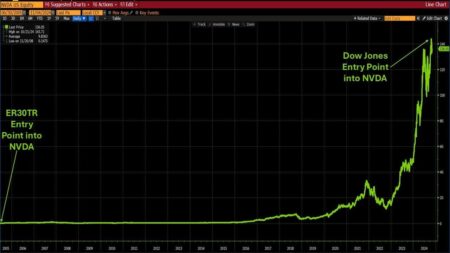Last week was another week of mixed performance for the stock market as the economic data, including the week-ending monthly jobs report, kept both stock and traders on edge.
Some of the early economic data like ISM Manufacturing came in weaker than expected which encouraged those hoping for a rate cut. Yields moved lower for the first four days of the week but then rallied sharply on Friday.
The culprit was the monthly jobs report as estimates were for 190,000 new jobs but instead, it came in at 272,000. The stock index futures reversed to the downside and yields rose sharply Before the report futures traders had chances of a rate cut in September at 70% but afterward, chances quickly dropped to 55%.
The Nasdaq 100 despite its lower close on Friday was up an impressive 2.5% last week as it made a new all-time high. It is still the leader year-to-date as it is up 12.93% but the S&P 500 is not far behind gaining 12.1% as it recorded a 1.3% gain last week. The Dow Jones Industrial Average was the only market higher last week.
On the downside, the Dow Jones Utility Average was the weakest down 2.8% followed by a 2.2% decline in the iShares Russell 2000. The SPDR Gold Shares were up ahead of the week but then reversed on Friday as it dropped 3.6% on the day.
The Invesco QQQ Trust (QQQ) had a high of $465.74 and then closed at $462.96 after opening at $463. Therefore a doji was formed Friday as it closed 2.1% above the rising 20-day EMA at $453.30. The May 31st low was $443.05 (dashed line) and then at $433.65.
As QQQ was making a new high last week (line a) the Nasdaq 100 Advance/Decline line was forming lower highs, line b, which created a negative divergence. A decline below the prior lows will confirm the divergence with stronger A/D line support at line c. The daily relative performance is back to the recent highs and is above its rising EMA which indicates QQQ is leading the SPY.
The T&J’s Theme WatchList from Friday’s close shows that 75% of the Nasdaq 100 largest stocks did close the week above their QPIvots. There were negative 1_HR DTS signals Friday on MSFT, AMGN, META, and AVGO. However, I would be more worried about 3_DTS signals in the week ahead so I will be monitoring this data daily during the week.
The small-cap ETFs like the iShares Russell 2000 (IWM) got the market’s attention by moving higher in early May. The rally weakened as the month progressed as the uptrend, line b, was broken last week. The starc- band is at $198.05 with further support in the $195-$196 area.
The negative outlook is supported by the Russell 2000 A/D line as it has been below its WMA since May 22nd. It dropped sharply at the end of the week. The RS (not shown) has dropped to a new low for the year indicating that IWM is still weaker not stronger than the SPY.
The 10-year T-Note yield dropped below the daily starc- band on Tuesday, Wednesday, and Thursday. The deeply oversold conditions made a rebound overdue on Friday and the stronger-than-expected jobs report was the right catalyst. Yields rose from a low of 4.245% to close at 4.441%. The downtrend, line a, is at 4.603%. The daily MACDs are negative and the weekly (not shown) are close to turning negative.
This week we have the CPI report on Wednesday morning with the FOMC announcement and a press conference in the afternoon. This will be followed by the PPI report on Thursday with the mid-month reading on Consumer Sentiment on Friday. The best opportunities occur when the A/D lines are trending higher which is not the case right now especially with the Nasdaq 100 A/D line diverging.
Read the full article here
















